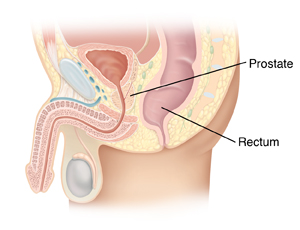Prostate Needle Biopsy
Prostate Needle Biopsy
Prostate needle biopsy is a test to look for prostate cancer. During the test, a thin, hollow needle is used to take small samples of tissue from the prostate. The samples are then tested in a lab.
Getting ready for the procedure
Prepare as you have been told. In addition to the following:
Tell your healthcare provider about all medicines you take. This includes herbs and other supplements. It also includes any blood thinners, such as warfarin, clopidogrel, or daily aspirin. You may need to stop taking some or all of them before the procedure.
You may be told to use a laxative, enemas, or both before the biopsy. This is to empty the colon and rectum of stool. Follow the instructions you are given.
Your healthcare provider may prescribe antibiotics before the procedure. If so, take these as directed.
Risks and possible complications
All procedures have risks. The risks of this procedure include:
Discomfort in the prostate area
Infection in the urinary tract or prostate
Infection in the bloodstream
Rectal or urinary bleeding
The day of the procedure
The procedure is done in a healthcare provider’s office or a hospital. It takes about 45 minutes. You will be able to go home the same day. Transrectal ultrasound is often used during the procedure. This test uses sound waves to make images on a computer screen. The images help the healthcare provider insert the needle in the correct place. During the biopsy:
If ultrasound will be used, you may be asked to drink water to fill your bladder.
You may lie on your side on an exam table.
The ultrasound transducer, which is about the size of a finger, is lubricated. It is then inserted into the rectum. This will feel like a prostate exam. The transducer is moved until the prostate can be seen in the ultrasound images.
To numb the biopsy area, local anesthetics may be injected. You might also be given medicine to make you sleepy.
Using the ultrasound images as a guide, the biopsy needle is inserted. It may be inserted through the rectum or through the skin between the scrotum and the anus (perineum).
The needle is used to take tissue samples from the prostate. About 12 samples are taken from different areas of the prostate. These samples are sent to a lab to be tested for cancer.
After the biopsy
At first you may feel a little lightheaded, especially if you had medicine to make you sleepy. You can lie on the table until you feel able to stand. You can go home once you are feeling better. You can go back to your normal activities. You may have some blood in your urine or stool that day. This is normal. You may also notice blood in your semen for weeks after the biopsy. This is normal and not dangerous. Your healthcare provider can tell you more about what to expect.
Follow-up care
You will see your healthcare provider for a follow-up visit. Depending on the biopsy results, you may be scheduled for more tests. If signs of cancer are found, you and your healthcare provider can discuss options for further testing.
When to call your healthcare provider
Call your healthcare provider right away if you have any of the following:
Blood clots in your urine
Bloody diarrhea
Blood in the urine or stool that doesn’t go away after 48 hours
Chest pain or trouble breathing (call 911)
Chills
Feeling of weakness
Fever of 100.4°F (38°C) or higher, or as directed by your healthcare provider
Inability to urinate
Updated:
September 02, 2017
Reviewed By:
Alteri, Rick, MD,Gersten, Todd, MD
